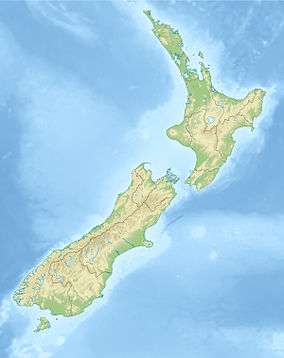2014 Eketahuna earthquake
 | |
| Date | 20 January 2014 |
|---|---|
| Origin time | 3:52 pm NZDT (UTC+13) |
| Magnitude | 6.2 ML |
| Depth | 34 kilometres (21 mi) |
| Epicenter | 40°37′S 175°52′E / 40.62°S 175.86°ECoordinates: 40°37′S 175°52′E / 40.62°S 175.86°E |
| Type | Oblique-normal |
| Areas affected | New Zealand |
| Peak acceleration | 0.26 g |
| Aftershocks | 1112 |
| Casualties | 3 injured |
The 2014 Eketahuna earthquake struck at 3:52 pm on 20 January, centred 15 km east of Eketahuna on the south-east of New Zealand's North Island. It had a maximum perceived intensity of VII (severe) on the Mercalli intensity scale.[1] Originally reported as magnitude 6.6 on the Richter Scale, the earthquake was later downgraded to a magnitude of 6.2. A total of 1112 aftershocks were recorded, ranging between magnitudes 2.0 and 4.9 on the Richter Scale.[2]
Tectonic setting
New Zealand lies along the boundary between the Indo-Australian Plate and Pacific Plates. In the South Island most of the relative displacement between these plates is taken up along a single dextral (right lateral) strike-slip fault with a major reverse component, the Alpine Fault. In the North Island the displacement is mainly taken up along the Hikurangi Subduction Zone, although the remaining dextral strike-slip component of the relative plate motion is accommodated by the North Island Fault System (NIFS).[3]
The focal mechanism of the earthquake, its depth and the distribution of aftershocks show that it was a result of oblique normal faulting within the upper part of the subducting Pacific Plate, with the rupture terminating upwards at the plate interface.[4]
Damage
It was felt strongly down the country, from Auckland in the north to Dunedin in the south, and more than 9,000 reports were submitted by the public to GeoNet, the geological hazards monitoring network. The New Zealand Herald newspaper reported damage to walls and chimneys and road closures in the lower North Island.[5]
The Earthquake Commission, (EQC) received 5,013 claims, 1,514 of them from Palmerston North. Minor to moderate damage was also reported in Eketahuna, Wellington, Masterton, Carterton, Kapiti Coast, Pahiatua, Levin and Otaki.[6] Three 1920s-style buildings in Masterton were evacuated after cracks appeared. One building needed to be demolished. According to The New Zealand Herald, two people were injured as a result of falls.[5]
Hokowhitu Lagoon in Palmerston North is thought to have suffered water-bed damage leading to water leaking. Currently no fix is in place to solve this.[7]
See also
References
- ↑ "New Zealand Earthquake Report Magnitude 6.2, Mon, Jan 20 2014, 3:52:45 pm (NZDT)". GeoNet. Retrieved 28 August 2014.
- ↑ "Future Scenarios and Aftershocks". GeoNet. GeoNet. Retrieved 8 July 2014.
- ↑ Mouslopoulou,V.; Nicol,A.; Little, T.A.; Walsh, J.J. (2007). "Terminations of large strike-slip faults: an alternative model from New Zealand". In Cunningham, W. D.; Mann, P. Tectonics of Strike-Slip Restraining and Releasing Bends. Special Publications Geological Society London. 290. pp. 387–415. ISBN 9781862392380.
- ↑ Abercombie R.E.; Bannister, S.C.; Francois-Holden, C.; Hamling, I. J.; Ristau, J. P. "The 2014 Mw6.2 Eketahuna earthquake, Hikurangi subduction zone - normal faulting in the subducted Pacific Plate crust". Fall Meeting 2014, abstracts. AGU. Retrieved 20 June 2016.
- 1 2 "6.2-magnitude earthquake hits lower North Island - National - NZ Herald News". The New Zealand Herald. 2014-01-20. Retrieved 2016-06-17.
- ↑ "Eketahuna Claims Update | EQC Earthquake Commission". Eqc.govt.nz. 2014-04-24. Retrieved 2016-06-17.
- ↑ Rankin, Janine (7 December 2015). "Divers will be sent into the Hokowhitu lagoon to learn more about leak". The Manawatu Standard.